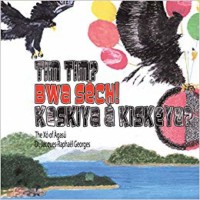Title: Tim Tim? Bwa Sech! Keskiya a Kiskeya?: The Xo of Agasu
Author: Jacques-Raphael Georges
Publisher: XlibrisUS
ISBN: 978-1-543437656-9
Pages: 222
Genre: Historic Fiction
Reviewed by: Carol Davala
Pacific Book Review
In an imaginative effort to explore, educate, and keep the culture and history of his native Haiti alive, Jacques-Raphael Georges’ Tim Tim? Bwa Sech! Keskiya a Kiskeya?: The Xo of Agasu reveals an unusual blend of story, folklore, and pictorial travelogue to reflect on the evolution of a country, its heritage, and its people.
Divided into two books, the opening makes use of an interesting conduit with the narrator as a self-imposed messenger relating the stories of an ancient ancestor known as Agasu. In “The Eagle and The Birthday Cake”, the Kiskeya people follow a path to American shores in search of their birthright. “A Hundred and One Rivers” honors a Godmother’s vocal objections to sub-standard living and reveals a lesson about taking initiative in order to receive assistance. Another narrative entwines the history, traditions, and values of the old Kiskeya ways vs. those of a new generation. Book II’s tales revolve around the friendship of characters Uncle Bouki and Konpe Malis. Here a daughter’s pilgrimage to study her ancestral roots, brings to light concerns that “Kiskeyans have lost their good old African soul”, and change is necessary for a positive future. For those with little or no knowledge of the French or Creole language, Georges’ use of unfamiliar words or expressions throughout the stories can be a bit disconcerting. While some phrases are translated or easily absorbed within the context of the story lines, others deserve more clarity.
A hefty portion of Book II is given to a wide range of photographs. Subject matter here varies from costumed dancers and an island mass, to portrait and group snapshots which appear to be the author and/or acquaintances encountered in his travels. An artistic culture dominates as many of the images depict a featured festival. Within this warm, tropical environment, sculpted statues are prominent; whether a whimsical spotted leopard, a mythical three-headed entity, or the crafted beauty of an umbrella- topped tree trunk wrapped in carvings of human and animal forms. In a comic moment, a visitor takes the same thoughtful pose of a statue. These memorable photos also capture colorful native attire, three-dimensional story murals, dance groups, and the religious component of a large cross that stands out against a memorial wall.
While many of the photos are self-explanatory, several seem of a more personal nature; hence captions would go a long way in making this a more relatable and shared experience for all readers. Though the fictional storytelling premise may suggest a younger target audience, perhaps a broader appeal exists for adults drawn to the book’s less academic framework.
Additional visuals provide a compliment to the book’s focus on Kiskeya. Indicative of the narrative, it is a world of contrasts. The aesthetic of large homes, waterscapes, statues, and flower-topped stone walls cannot dismiss the poverty of old cars and crowded streets strewn with garbage. In correlation between the Haitian and Cuban nations and their struggles recognized within the narrative, and the “Little Havana” and “Little Kiskeya” cultures brought to the southern US, the final pictorials take us to the hub-bub of Cuba. It is a tourist draw showcasing old world architecture, vibrant early model cars, Carmen Miranda-style costume spectaculars and artful political statements.
Ultimately through this creative collection of stories and imagery, audiences searching for an unusual perspective from which to consider the culture and history of a small Caribbean nation will be enticed while reading Tim Tim? Bwa Sech! Keskiya a Kiskeya?: The Xo of Agasu.


